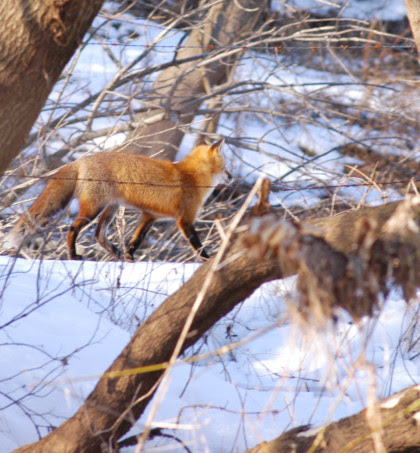January Snow, An Open Book Exam
Article and photos by Joe Mish

The snowflakes reflected in the street light outside my bedroom window to give hope to a day off from school and a predawn visit to the land where the wild rabbits roamed. Rabbits were at the far end of the spectrum of big game animals but shared the stage with cape buffalo, lions, leopards, rhino and elephants. Locally, rabbits were the best we could do and were attributed full big game status typically accorded to the celebrated, ‘dangerous five’ that roamed the continent of darkest Africa.
Rabbit tracks are easy to recognize with the two widespread hind feet and two centered front paws. The obvious first question to be answered when first seeing rabbit tracks is always, ‘which way are they headed’. Seeing a bunny and backtracking it will reveal the important directional information.
For a budding naturalist, fresh fallen snow is akin to taking an open book exam and a guaranteed A+. Animal tracks were everywhere and in the best tradition of Sherlock Holmes, invited investigation, imagination and a theory of resolution. The maze of rabbit tracks evident in the predawn light were nearly impossible to untangle. It appeared as if hundreds of bunnies randomly danced to some mysterious tune leaving footprints reminiscent of an Arthur Murray, ‘learn to dance’ floor mat with outlined footprints. The foxtrot and bunny hop surely had to be popular among the cottontail youth.
If you find tracks in the early morning snow, realize they were made hours earlier and appear to trace endless miles of travel in a rather confined area. “What was this bunny thinking?” would be a valid question.
Food is a primary concern and feeding areas will have the most tracks as local bunnies recognize where the supermarkets grow. Of course an active social life interferes with nibbling an oak twig or a withered raspberry leaf and that is reflected in the snow lining the aisles of the cold food section.
The obvious conclusion to unraveling the confusing tracks was to wake up earlier in hopes of finding a single track or perhaps actually seeing a bunny. Problem was the snow had already been tracked up in an undecipherable mess that required tracking abilities far beyond boyhood skills. The only hope for another chance was a new snow fall.
Flipping the tv dial from the Our Gang Comedies to catch the next day’s weather forecast seemed sacrilegious or perhaps antagonistic to my little sister, but anticipation of new snow was insatiable. Loss of faith in the weatherman led to observing the nighttime sky for signs of impending snow. If the temperature hovered at or below 32 degrees and there was a ring around the moon, hopes were high that snow was on its way and the next trip to Bunnyville would be a resounding success.
What would success look like if it were to happen?
Though rabbits were substituted for leopards, the hope was to unlock the mystery of a wild animal’s movement to reveal its most intimate secrets and eventually accumulate skills appropriate for tracking lions and African elephants. None of this could ever happen unless fresh snow covered the cold ground and school was cancelled.
The most fun is to find the tracks of a startled rabbit and pace off the distance between leaps. I watched a fox sneak up on a pair of bunnies and it was clear the fox couldn’t make a decision as to which critter to take to dinner. His indecision left him looking like a foolish fox, who, after a short chase, failed to appreciate the acrobatic display the two rabbits put on. The tracks they left were decipherable only because the scene was observed.
Favorite foods will be surrounded with tracks and the telltale sign of an angled cut, sliced as if with a razor, are a rabbit’s trademark. Deer, on the other hand, have no upper front teeth and leave a ragged tear as they trim your shrubbery. Cottontail rabbits actually have four upper front teeth which classifies them as lagomorphs rather than rodents
Persistent pursuit over brimming with hope, fresh snow and rabbit tracks eventually began to unravel and reveal a satisfactory knowledge of what rabbits did and where they did it. Not surprising, the rabbit tracks led to a lifetime of curiosity and wonder which spread out as a ripple in a quiet pond to reach far beyond the shores of the neighborhood claybanks.
Following rabbit tracks in the snow had become the loose thread that begs attention and always leads to reveal the weave of the cloth. Overwhelming and complex concepts or problems are best approached by following what appear to be insignificant loose threads.
A fresh snow, imprinted with deer, rabbit or fox tracks, is sure to arrive this January. Some curious person will be compelled to follow those tracks that will lead to a lifetime of natural curiosity, wonder and transferable skills, useful in as yet, many unimaginable ways.
Author Joe Mish has been running wild in New Jersey since childhood when he found ways to escape his mother’s watchful eyes. He continues to trek the swamps, rivers and thickets seeking to share, with the residents and visitors, all of the state’s natural beauty hidden within full view. To read more of his writing and view more of his gorgeous photographs visit Winter Bear Rising, his wordpress blog. Joe’s series “Nature on the Raritan, Hidden in Plain View” runs monthly as part of the LRWP “Voices of the Watershed” series. Writing and photos used with permission from the author. Contact jjmish57@msn.com. See more articles and photos at winterbearrising.wordpress.com.
